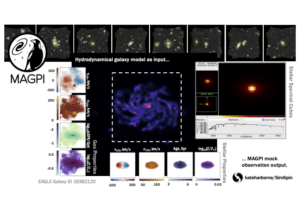Project area/S
- The Distant Universe / Cosmological Theory
Project Details
From spectacular spiralling disks to bulging red ellipticals, what are the processes that dominate to produce the variety in galaxy structures we observe in the local Universe? This is the main question we aim to answer with the MAGPI survey, a large program on ESO’s MUSE/VLT. Looking back ~10 billion years, this survey is collecting integral field spectroscopic (IFS) data at exquisite resolution for approximately 160 galaxies at z~0.3 to understand how galactic structures and their dynamics have evolved over time.
Alongside these observations, the MAGPI team are working hand-in-hand with cosmological theory. We are generating realistic MUSE mock observations of five of the most popular cosmological simulations to date: EAGLE, Magneticum, HorizonAGN, TK15 and IllustrisTNG. Each of these simulations predicts a different formation process for galaxies at this epoch (z~0.3), giving us an ideal test for our understanding of galaxy evolution.
In this studentship, you will be helping to generate mock observations for the IllustrisTNG simulation using the tool SimSpin. This will involve:
• developing code to work directly with large cosmological simulations,
• generating a number of mock observations for the MAGPI team and,
• performing kinematic analysis of MUSE data cubes.
Using these observations, we will analyse the kinematic structures at z~0.3 and attempt to diagnose the key features that lead to rapid dynamical changes.
Student Attributes
Academic Background
Some experience with coding would be preferred.
Computing Skills
Familiarity and experience with either Python or R (both would be amazing!).
Training Requirement
Continuous development practices (i.e. working with Git and developing a code base with testing framework etc.)
Project Timeline
- Week 1 Inductions and project introduction
- Week 2 Initial Presentation
- Week 3 Working with IllustrisTNG. Becoming familiar with how the data within the simulation is presented, how to formulate comparable “cut-out” galaxies to the others within the MAGPI survey.
- Week 4 Generating the IllustrisTNG data set. Reading and writing HDF5 files. Beginning to integrate the format with existing SimSpin software. Becoming familiar with the Git process and merging/developing code packagess
- Week 5 Building mock MAGPI observations for the IllustrisTNG data set.
- Week 6 Testing the mock observations
- Week 7 Kinematic analysis of mock observations. Updating existing code to produce equivalent measurements to particle-based analysis.
- Week 8 Continuing kinematic analysis.
- Week 9 Final Presentation
- Week 10 Final Report

Mock MUSE (MAGPI) view of a galaxy from the EAGLE simulation
